The global electrical testing services market is valued at USD 8.9 billion in 2025 and is slated to reach USD 18.2 billion by 2035, recording an absolute increase of USD 9.3 billion over the forecast period. This translates into a total growth of 104.5%, with the market forecast to expand at a compound annual growth rate (CAGR) of 7.4% between 2025 and 2035. The overall market size is expected to grow by nearly 2.0X during the same period, supported by increasing digital infrastructure expansion, growing aging electrical infrastructure concerns, and rising adoption of smart grid technologies across diverse industrial and commercial applications.
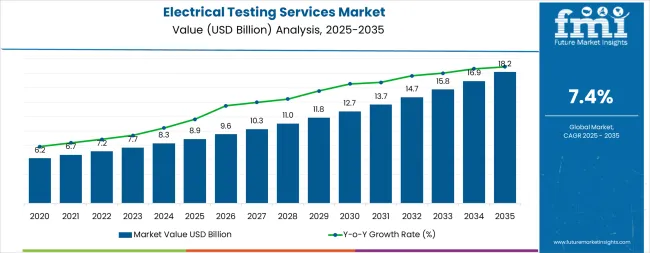
Between 2025 and 2030, the electrical testing services market is projected to expand from USD 8.9 billion to USD 12.8 billion, resulting in a value increase of USD 3.9 billion, which represents 41.9% of the total forecast growth for the decade. This phase of development will be shaped by increasing data center expansion projects, rising industrial automation initiatives, and growing adoption of predictive maintenance solutions in electrical systems applications. Service providers are expanding their technological capabilities to address the growing demand for advanced testing solutions and enhanced operational reliability.
| Metric | Value |
|---|---|
| Estimated Value in (2025E) | USD 8.9 billion |
| Forecast Value in (2035F) | USD 18.2 billion |
| Forecast CAGR (2025 to 2035) | 7.4% |
From 2030 to 2035, the market is forecast to grow from USD 12.8 billion to USD 18.2 billion, adding another USD 5.4 billion, which constitutes 58.1% of the overall ten-year expansion. This period is expected to be characterized by the expansion of smart grid infrastructure, the integration of IoT-enabled testing technologies, and the development of specialized cybersecurity testing solutions for major electrical and power infrastructure projects. The growing adoption of digital transformation programs and automated monitoring initiatives will drive demand for electrical testing services with enhanced technological capabilities and reduced operational complexity.
Between 2020 and 2025, the electrical testing services market experienced steady growth, driven by increasing infrastructure modernization and growing recognition of electrical testing as essential services for operational safety and regulatory compliance. The market developed as industrial operators and facility managers recognized the potential for advanced testing technologies to enhance operational efficiency while reducing downtime costs and improving safety standards. Technological advancement in predictive analytics and IoT-based monitoring began emphasizing the critical importance of maintaining system reliability and operational safety in electrical infrastructure applications.
Market expansion is being supported by the increasing aging electrical infrastructure and the corresponding need for comprehensive testing services that can maintain operational reliability and safety compliance while supporting diverse industrial applications across various electrical environments. Modern facility managers and industrial operators are increasingly focused on implementing testing solutions that can reduce downtime risks, minimize operational costs, and provide consistent performance in electrical system operations. Electrical testing services' proven ability to deliver enhanced safety assurance, reliable operational capabilities, and versatile infrastructure applications make them essential services for contemporary industrial operations and facility management solutions.
The growing emphasis on digital infrastructure development and operational efficiency is driving demand for electrical testing services that can support high-tech applications, reduce system failures, and enable efficient electrical system operations across varying industrial configurations. Industrial operators' preference for services that combine reliability with technological advancement and regulatory compliance is creating opportunities for innovative testing implementations. The rising influence of smart grid technologies and automated monitoring systems is also contributing to increased adoption of electrical testing services that can provide advanced operational control without compromising performance or safety standards.
The electrical testing services market is poised for robust growth and transformation. As industrial operators across both developed and emerging markets seek electrical services that are reliable, technologically advanced, compliant, and operationally effective, electrical testing systems are gaining prominence not just as maintenance services but as strategic infrastructure for operational efficiency, safety enhancement, system reliability improvement, and regulatory compliance.
Rising digitalization and infrastructure modernization in South Asia, East Asia, and Western Europe amplify demand, while service providers are picking up on innovations in IoT technologies and predictive analytics systems.
Pathways like data center services, smart grid integration, and predictive maintenance promise strong margin uplift, especially in developed markets. Geographic expansion and service diversification will capture volume, particularly where industrial activities are growing or electrical infrastructure requires modernization. Technology pressures around system reliability, safety compliance, operational efficiency, and digital transformation give structural support.
The market is segmented by service type, end use, and region. By service type, the market is divided into transformer testing, circuit breaker testing, protection testing, battery testing, rotating equipment vibration testing, motors/generator testing, and thermographic testing. By end use, it covers power generation stations, transmission and distribution stations, steel plants, major refineries, railways, data centers, healthcare and hospitality, commercial establishments, and others. Regionally, the market is divided into North America, Latin America, Western Europe, Eastern Europe, East Asia, South Asia, and Middle East & Africa.
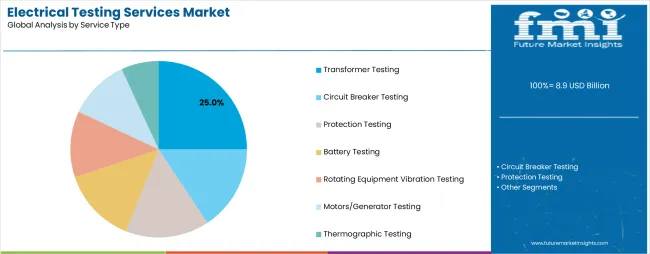
The motors/generator testing segment is projected to register the highest growth rate at 25% CAGR through 2035, positioning itself as the leading service innovation category. Industrial operators and facility managers increasingly utilize motors/generator testing for their critical operational importance, energy efficiency optimization, and reliability requirements across manufacturing, power generation, and infrastructure applications. Motors/generator testing technology's predictive maintenance capabilities and condition monitoring characteristics directly address the industrial requirements for reliable equipment operation and operational efficiency in diverse electrical environments.
This service segment forms the foundation of modern industrial operations, as it represents the technology with the greatest operational impact and proven maintenance effectiveness across multiple applications and industrial scenarios. Operator investments in enhanced motor testing systems and condition monitoring continue to strengthen adoption among manufacturing companies and power generation facilities. With operators prioritizing equipment reliability and energy efficiency, motors/generator testing aligns with both operational performance objectives and cost management requirements, making them the central component of comprehensive electrical maintenance strategies.
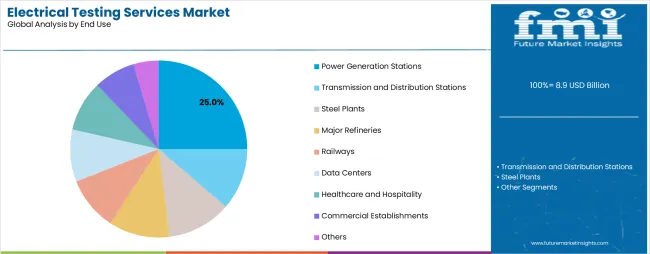
Data Centers are projected to represent 25% of electrical testing services demand in 2025, underscoring their critical role as the primary growth driver for mission-critical electrical infrastructure and 24/7 operational requirements. Data center operators prefer electrical testing services for their reliability, uptime requirements, and ability to support continuous operations while ensuring system redundancy and operational safety requirements. Positioned as essential services for modern digital infrastructure, data center testing offers both operational advantages and business continuity benefits.
The segment is supported by continuous innovation in hyperscale infrastructure and the growing availability of specialized testing configurations that enable efficient system monitoring with enhanced reliability capabilities. Data center operators are investing in advanced testing solutions to support large-scale operations and digital service delivery. As cloud computing becomes more prevalent and digital transformation requirements increase, data centers will continue to dominate the end use market while supporting advanced testing utilization and digital infrastructure operational strategies.
The electrical testing services market is advancing steadily due to increasing aging electrical infrastructure and growing adoption of safety compliance requirements that provide enhanced operational reliability and regulatory adherence across diverse industrial applications. However, the market faces challenges, including high service costs, skilled technician shortages, and varying regulatory requirements across different operational environments. Innovation in IoT technologies and predictive analytics continues to influence service development and market expansion patterns.
The growing concern over aging electrical infrastructure and safety compliance requirements is enabling service providers to develop electrical testing capabilities that provide superior system reliability, enhanced safety assurance, and consistent performance in critical infrastructure environments. Advanced electrical testing services provide improved operational safety while allowing more effective preventive maintenance and consistent regulatory compliance across various applications and industrial requirements. Service providers are increasingly recognizing the competitive advantages of modern testing capabilities for operational efficiency and safety compliance positioning.
Modern electrical testing service providers are incorporating IoT monitoring and predictive analytics systems to enhance testing accuracy, reduce operational costs, and ensure consistent performance delivery to industrial and commercial operators. These technologies improve system reliability while enabling new applications, including remote monitoring and automated diagnostics solutions. Advanced technology integration also allows service providers to support premium positioning and operational optimization beyond traditional testing service supply.
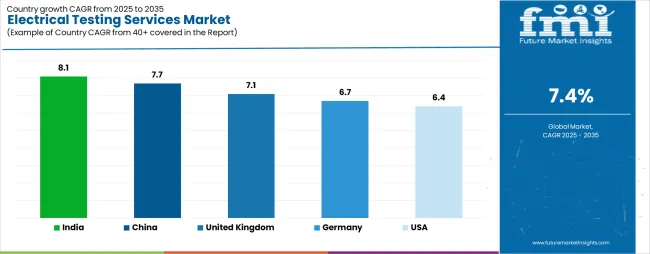
| Country | CAGR (2025-2035) |
|---|---|
| India | 8.1% |
| China | 7.7% |
| United Kingdom | 7.1% |
| Germany | 6.7% |
| United States | 6.4% |
The electrical testing services market is experiencing strong growth globally, with India leading at an 8.1% CAGR through 2035, driven by extensive industrialization programs, rapid infrastructure development, and significant adoption of electrical safety compliance solutions. China follows at 7.7%, supported by massive manufacturing expansion, advanced industrial capabilities, and growing adoption of smart grid technologies. United Kingdom shows growth at 7.1%, emphasizing safety standards and regulatory compliance requirements. Germany records 6.7%, focusing on industrial modernization and renewable energy integration. United States demonstrates 6.4% growth, supported by grid modernization programs and infrastructure upgrade initiatives.
The report covers an in-depth analysis of 40+ countries, the top-performing countries are highlighted below.
Revenue from electrical testing services in India is projected to exhibit exceptional growth with a CAGR of 8.1% through 2035, driven by extensive industrialization programs and rapidly growing adoption of electrical safety solutions supported by manufacturing expansion initiatives and infrastructure development requirements. The country's comprehensive industrial development strategy and increasing investment in electrical safety technologies are creating substantial demand for advanced testing services. Major manufacturing companies and industrial operators are establishing comprehensive testing programs to serve both domestic production needs and export manufacturing requirements.
Revenue from electrical testing services in China is expanding at a CAGR of 7.7%, supported by the country's massive manufacturing capabilities, comprehensive smart grid development, and increasing adoption of advanced testing systems. The country's established industrial infrastructure and growing emphasis on technological innovation are driving sophisticated testing capabilities. Manufacturing companies and power operators are establishing extensive testing operations to address the growing demand for system reliability and operational efficiency.
Revenue from electrical testing services in United Kingdom is growing at a CAGR of 7.1%, driven by expanding safety standards enforcement, increasing regulatory compliance requirements, and growing investment in electrical system reliability enhancement. The country's established regulatory framework and emphasis on operational safety are supporting demand for advanced testing technologies across major industrial markets. Industrial operators and facility managers are establishing comprehensive testing programs to serve both domestic safety needs and regulatory compliance requirements.
Revenue from electrical testing services in Germany is expanding at a CAGR of 6.7%, supported by the country's focus on industrial modernization, comprehensive renewable energy integration, and strategic investment in electrical system enhancement. Germany's established industrial infrastructure and emphasis on operational excellence are driving demand for specialized testing technologies focusing on system reliability and energy efficiency. Industrial operators are investing in comprehensive testing modernization to serve both domestic industrial requirements and renewable energy operations.
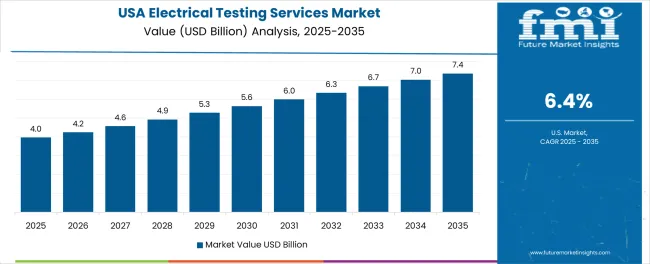
Revenue from electrical testing services in United States is expanding at a CAGR of 6.4%, supported by the country's focus on grid modernization capabilities, comprehensive infrastructure upgrade programs, and strategic investment in electrical system improvement. United States's established electrical infrastructure and emphasis on system reliability are driving demand for specialized testing technologies focusing on operational efficiency and grid modernization capabilities. Utility operators are investing in comprehensive testing enhancement to serve both domestic infrastructure requirements and technological advancement initiatives.
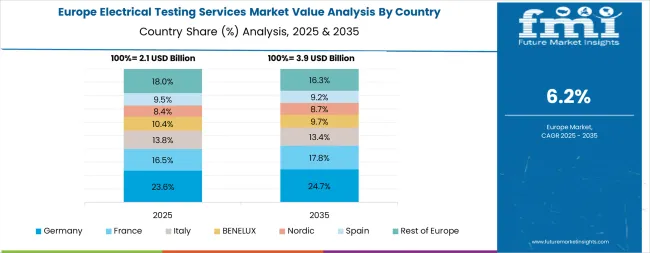
The electrical testing services market in Europe is projected to grow from USD 2.1 billion in 2025 to USD 3.9 billion by 2035, registering a CAGR of 6.4% over the forecast period. Germany is expected to maintain its leadership position with a 31.2% market share in 2025, increasing to 31.8% by 2035, supported by its advanced industrial infrastructure, comprehensive manufacturing capabilities, and major industrial facilities serving European and international markets.
United Kingdom follows with a 24.7% share in 2025, projected to reach 25.3% by 2035, driven by safety standards enforcement, regulatory compliance programs, and established industrial capabilities, but facing challenges from competitive pressures and infrastructure investment constraints. France holds a 18.9% share in 2025, expected to decline to 18.4% by 2035, supported by industrial modernization requirements and infrastructure development but facing challenges from regulatory adjustments and investment uncertainties. Italy commands a 12.6% share in 2025, projected to reach 12.8% by 2035, while Netherlands accounts for 8.7% in 2025, expected to reach 8.9% by 2035. The Rest of Europe region, including Nordic countries, Spain, Belgium, and other European countries, is anticipated to gain momentum, expanding its collective share from 3.9% to 4.2% by 2035, attributed to increasing industrial development across Nordic countries and growing infrastructure modernization across various European markets implementing advanced electrical system upgrade programs.
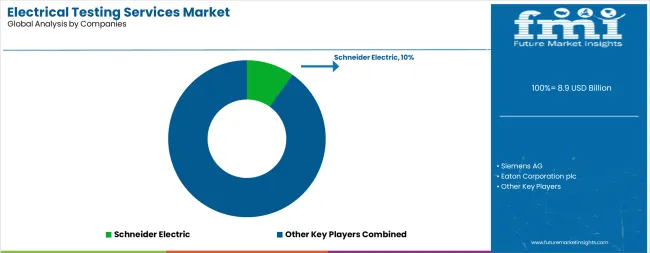
The electrical testing services market is characterized by competition among established electrical equipment manufacturers, specialized testing service providers, and integrated industrial service companies. Companies are investing in advanced IoT technology research, predictive analytics development, cybersecurity enhancement, and comprehensive service portfolios to deliver reliable, technologically-advanced, and compliant electrical testing solutions. Innovation in monitoring technology systems, automated diagnostic technologies, and specialized application capabilities is central to strengthening market position and competitive advantage.
Schneider Electric leads the market with a strong presence, offering comprehensive electrical testing and monitoring solutions with a focus on digital transformation and advanced automation capabilities for industrial and commercial operations. Siemens AG provides specialized industrial automation portfolios with an emphasis on technological innovation, predictive maintenance capabilities, and comprehensive service support. Eaton Corporation plc delivers integrated power management and testing solutions with focus on reliability and operational performance. General Electric Company specializes in industrial technologies with emphasis on grid modernization and energy efficiency. ABB Inc focuses on electrical solutions with advanced automation capabilities and technical expertise.
| Items | Values |
|---|---|
| Quantitative Units (2025) | USD 8.9 billion |
| Service Type | Transformer Testing, Circuit Breaker Testing, Protection Testing, Battery Testing, Rotating Equipment Vibration Testing, Motors/Generator Testing, Thermographic Testing |
| End Use | Power Generation Stations, Transmission and Distribution Stations, Steel Plants, Major Refineries, Railways, Data Centers, Healthcare and Hospitality, Commercial Establishments, Others |
| Regions Covered | North America, Latin America, Western Europe, Eastern Europe, East Asia, South Asia, Middle East & Africa |
| Countries Covered | United States, Japan, Germany, India, United Kingdom, France, Italy, Brazil, Canada, South Korea, Australia, Spain, Netherlands, Saudi Arabia, Switzerland, and 30+ countries |
| Key Companies Profiled | Schneider Electric, Siemens AG, Eaton Corporation plc, General Electric Company, ABB Inc, and others |
| Additional Attributes | Service sales by type and end use category, regional demand trends, competitive landscape, technological advancements in testing systems, IoT integration development, predictive analytics innovation, and operational efficiency optimization |
The global electrical testing services market is estimated to be valued at USD 8.9 billion in 2025.
The market size for the electrical testing services market is projected to reach USD 18.2 billion by 2035.
The electrical testing services market is expected to grow at a 7.4% CAGR between 2025 and 2035.
The key product types in electrical testing services market are transformer testing, circuit breaker testing, protection testing, battery testing, rotating equipment vibration testing, motors/generator testing and thermographic testing.
In terms of end use, power generation stations segment to command 25.0% share in the electrical testing services market in 2025.






Full Research Suite comprises of:
Market outlook & trends analysis
Interviews & case studies
Strategic recommendations
Vendor profiles & capabilities analysis
5-year forecasts
8 regions and 60+ country-level data splits
Market segment data splits
12 months of continuous data updates
DELIVERED AS:
PDF EXCEL ONLINE
India Electrical Testing Services Market Size and Share Forecast Outlook 2025 to 2035
North America Electrical Testing Services Market - Growth & Demand 2025 to 2035
Electrical Enclosure Market Size and Share Forecast Outlook 2025 to 2035
Electrical Sub Panels Market Size and Share Forecast Outlook 2025 to 2035
Electrically Conductive Adhesives Market Size and Share Forecast Outlook 2025 to 2035
Electrically-Driven Heavy-Duty Aerial Work Platforms Market Size and Share Forecast Outlook 2025 to 2035
Electrically Actuated Micro Robots Market Size and Share Forecast Outlook 2025 to 2035
Electrically Conductive Coating Market Size and Share Forecast Outlook 2025 to 2035
Electrical Conduit Market Analysis - Size, Share, and Forecast Outlook 2025 to 2035
Electrical Safety Personal Protection Equipment (PPE) Market Size and Share Forecast Outlook 2025 to 2035
Electrical Steering Column Lock Market Size and Share Forecast Outlook 2025 to 2035
Electrical Steel Market Growth - Trends & Forecast 2025 to 2035.
Electrical Coil Tester Market Analysis - Size, Share, and Forecast Outlook 2025 to 2035
Electrical Fuses Market Analysis – Growth & Forecast 2025 to 2035
Electrical Digital Twin Market Growth – Trends & Forecast 2025 to 2035
Electrical Bushings Market Trends – Growth & Forecast 2025 to 2035
Electrical Steel Coatings Market 2025-2035
Electrical Insulation Materials Market Trends 2024 to 2034
Electrical Label Market Demand & Industry Applications 2024 to 2034
Electrical Service Market Growth – Trends & Forecast 2024-2034

Thank you!
You will receive an email from our Business Development Manager. Please be sure to check your SPAM/JUNK folder too.
Chat With
MaRIA